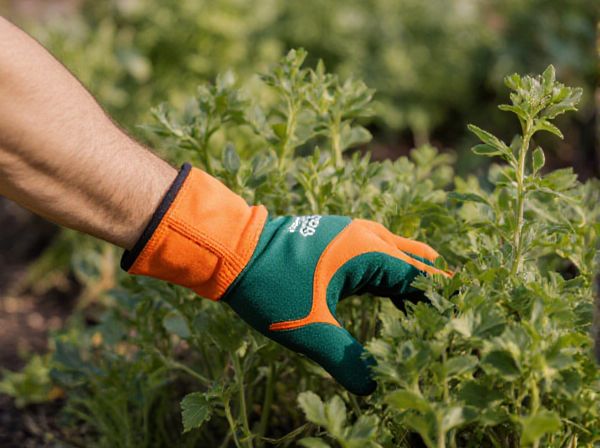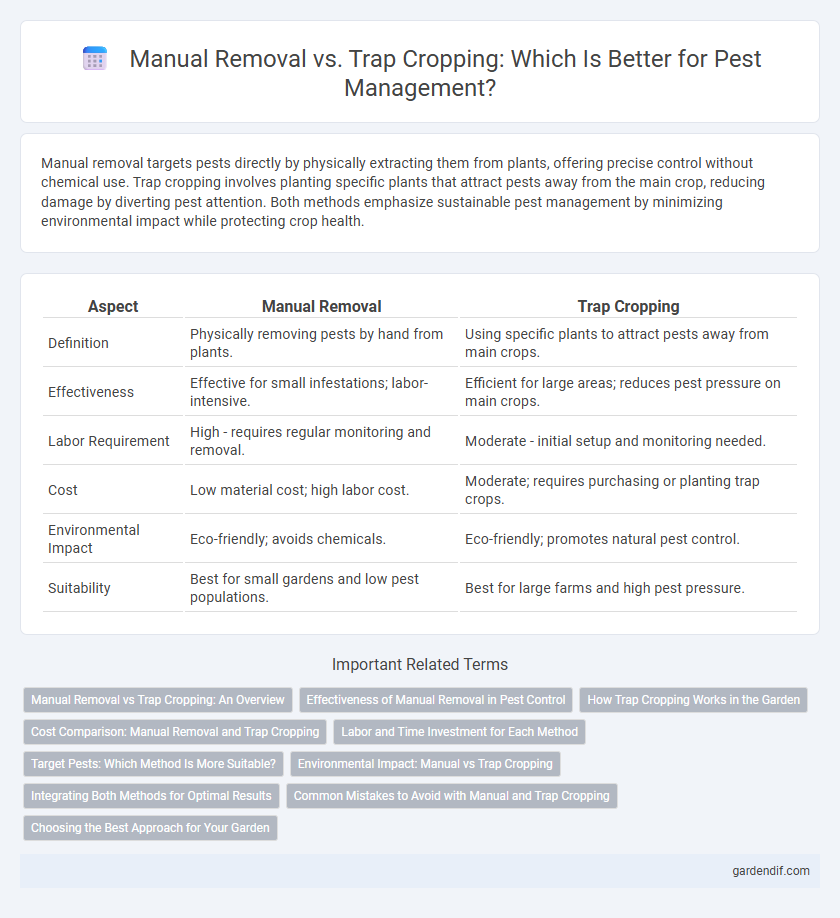
Manual removal vs Trap cropping Illustration
Manual removal targets pests directly by physically extracting them from plants, offering precise control without chemical use. Trap cropping involves planting specific plants that attract pests away from the main crop, reducing damage by diverting pest attention. Both methods emphasize sustainable pest management by minimizing environmental impact while protecting crop health.
Table of Comparison
| Aspect | Manual Removal | Trap Cropping |
|---|---|---|
| Definition | Physically removing pests by hand from plants. | Using specific plants to attract pests away from main crops. |
| Effectiveness | Effective for small infestations; labor-intensive. | Efficient for large areas; reduces pest pressure on main crops. |
| Labor Requirement | High - requires regular monitoring and removal. | Moderate - initial setup and monitoring needed. |
| Cost | Low material cost; high labor cost. | Moderate; requires purchasing or planting trap crops. |
| Environmental Impact | Eco-friendly; avoids chemicals. | Eco-friendly; promotes natural pest control. |
| Suitability | Best for small gardens and low pest populations. | Best for large farms and high pest pressure. |
Manual Removal vs Trap Cropping: An Overview
Manual removal involves physically extracting pests from plants, offering immediate control without chemical use but requiring significant labor and time investment. Trap cropping attracts pests to sacrificial plants, reducing damage to the main crop by diverting pest populations, thus providing a more sustainable pest management strategy. Both methods emphasize environmentally friendly pest control, with manual removal suited for small-scale operations and trap cropping effective for managing pest pressure across larger agricultural areas.
Effectiveness of Manual Removal in Pest Control
Manual removal proves highly effective in pest control by directly targeting and eliminating pests from plants, reducing infestations without chemical use. This method allows precise control over pest populations, minimizing damage while preserving beneficial insects and environmental health. However, its success depends on labor intensity and early detection, making it ideal for small-scale gardens or specific pest outbreaks.
How Trap Cropping Works in the Garden
Trap cropping works by planting specific crops that attract pests away from the main garden plants, creating a protective barrier for valuable crops. These sacrificial plants lure pests such as aphids, beetles, or caterpillars, concentrating infestations in a controlled area for easier management. This method reduces the need for chemical pesticides and minimizes damage, promoting a healthier, more sustainable garden ecosystem.
Cost Comparison: Manual Removal and Trap Cropping
Manual removal incurs higher labor costs due to intensive, ongoing physical effort required to extract pests individually, making it less economical for large-scale operations. Trap cropping involves initial investment in planting specific crops that attract pests away from main crops, potentially reducing pesticide expenses and labor over time. While trap cropping requires strategic planning and monitoring, it generally offers a cost-effective pest management solution compared to the repetitive expenses associated with manual removal.
Labor and Time Investment for Each Method
Manual removal demands significant labor and time investment, as workers must carefully identify and eliminate pests individually, often requiring frequent monitoring and repeated efforts to maintain control. Trap cropping involves initial planning and planting of sacrificial crops, which can reduce ongoing labor by attracting pests away from main crops, but it requires time for crop establishment and monitoring to ensure pests remain on trap plants. Overall, manual removal is more labor-intensive and time-consuming on a continuous basis, whereas trap cropping shifts labor investment primarily to the setup and monitoring phases.
Target Pests: Which Method Is More Suitable?
Manual removal is highly effective for controlling small populations of target pests such as aphids, caterpillars, and beetles by directly reducing their numbers without chemical use. Trap cropping is more suitable for managing larger infestations of pests like flea beetles, stink bugs, and diamondback moths by attracting them to sacrificial plants, thereby protecting main crops. The choice between manual removal and trap cropping depends on pest population density, pest behavior, and crop type to maximize pest suppression efficiently.
Environmental Impact: Manual vs Trap Cropping
Manual removal of pests minimizes environmental impact by eliminating chemical use, preserving beneficial insect populations and soil health. Trap cropping diverts pests to designated plants, reducing pesticide reliance but may require more land and management efforts, potentially affecting local biodiversity. Both methods support sustainable pest control, with manual removal favoring direct intervention and trap cropping promoting ecological balance.
Integrating Both Methods for Optimal Results
Integrating manual removal with trap cropping enhances pest management by combining immediate pest reduction and targeted pest diversion. Manual removal eliminates pests directly from the primary crop, while trap crops attract and concentrate pests away, minimizing damage. Together, these methods reduce pesticide dependency and promote sustainable, eco-friendly pest control.
Common Mistakes to Avoid with Manual and Trap Cropping
Manual removal of pests often fails when individuals overlook thorough inspection, missing early infestations that lead to population resurgence. Trap cropping can be ineffective if the selected trap plants are not attractive enough or if they are placed improperly, resulting in pests migrating to main crops instead of being contained. Avoiding these mistakes requires consistent monitoring and strategic planning to ensure pest populations are accurately targeted and managed.
Choosing the Best Approach for Your Garden
Manual removal offers precise control over pest populations by physically extracting insects or larvae, ideal for small or manageable infestations. Trap cropping strategically plants sacrificial crops to attract pests away from main plants, reducing damage and minimizing chemical use for larger or diverse gardens. Assessing garden size, pest type, and labor availability helps determine the most effective approach to maintain healthy plant growth and optimize yield.
Manual removal vs Trap cropping Infographic

 gardendif.com
gardendif.com